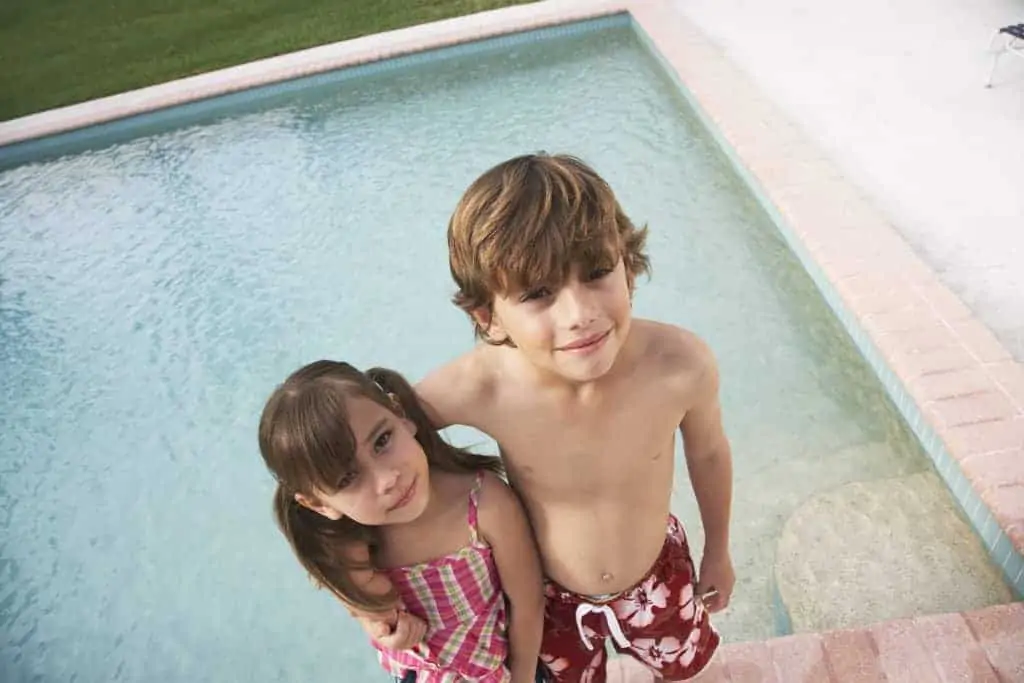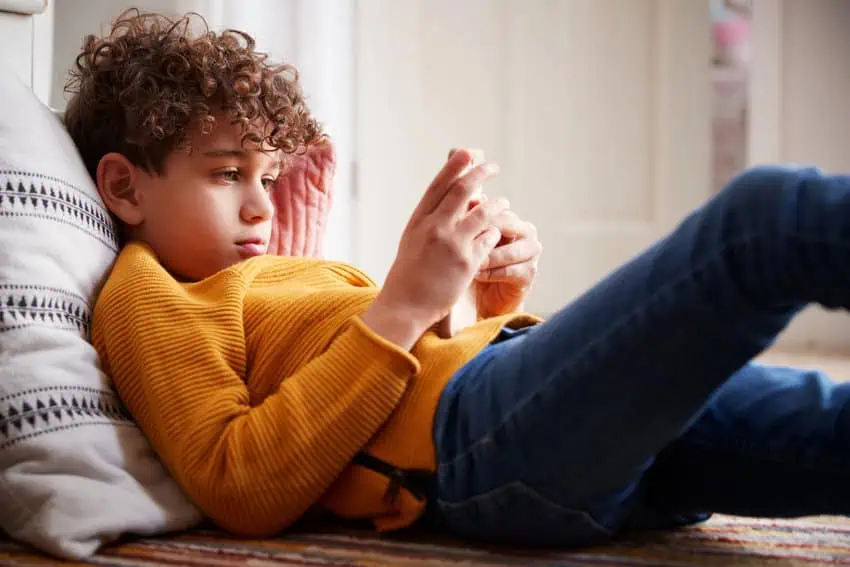Secondary drowning (also know as Dry Drowning) requires immediate medical intervention. Secondary drowning is also called delayed drowning because it can happen anywhere from 1-24 hours after being in water and getting fluid in the lung. Be equipped with the facts on dry drowning and secondary drowning symptoms. Save your child from secondary drowning by spotting dry drowning signs quickly.
What You Need to Know About the Warning Signs of Secondary Drowning
I had no idea about secondary drowning (what is also referred to as dry drowning, but also medically called delayed drowning or silent drowning) until I was a parent.
It’s another scary situation in a long line of others you should know about to keep your kids safe around water.
What’s the Difference Between Secondary Drowning and Dry Drowning?
Secondary Drowning is where a child seems fine after getting out of the pool or a body of water, but then begins to shown signs of trouble breathing such as shortness of breath, persistently coughing and exhibiting symptoms similar to a cold or the flu, such as extreme fatigue, sleepiness, vomiting and sometimes fever.
While secondary drowning is extremely rare, it can be life threatening and requires immediate medical attention.
You may think that once you’re out of the water, your child is safe but secondary drowning symptoms can happen anywhere from 1 – 24 hours after you’ve been swimming.
Tragically, this four-year old boy died one week after swimming and the cause was found to be from secondary drowning.
This sounds scary, but if you know the dry drowning signs and how to handle it, it can be monitored and treated before the situation turns critical. These water conditions aren’t common and the symptoms in small children will be obvious because you’ll intuitively know something isn’t right.
Get the facts you need to help keep your kids safe in and out of water. Read and know the signs of dry drowning and secondary drowning.
Need or Want to Learn CPR?
Thrive Training offers an online CPR and AED Training Course so you can be CPR certified in your home in less than one hour. I recently updated my CPR training which is valid for two years through Thrive Training and do so every time it expires.
Use my code Corinne10 to get $10 off your registration.
It’s never NOT a good idea to know CPR if not for your own kids, for family, friends and anyone who may need your help one day.
What Dry Drowning Looks Like
When a child breathes a small amount of water into their lungs, something that can happen when there struggling to swim, gets splashed in the face, goes underwater, swallows a little bit of water, or is dunked, the water that’s breathed in through the mouth or nose isn’t correctly expelled and gets caught in the child’s airways.
The vocal cords then begin to spasm from the aspirated water that causes inflammation, the lungs begin to swell and close up after you’ve left the pool.
This is dry drowning.
Water in the lungs can cause swelling that forces the airways to close shut, making it difficult, if not impossible for a person to breathe.
Dry drowning usually happens immediately after the child has breathed water into their lungs, and you’ll notice these symptoms of dry drowning quickly.
It’s always best to visit a urgent care center if you suspect any problems after swimming.
Why Secondary Drowning is Different Than Dry Drowning
Dry drowning is when breathing becoming difficult because the airways close up, but secondary drowning is slightly different.
When water is consumed in the lungs, it begins to fill the lungs, until it causes the person several trouble breathing. This condition is called pulmonary edema.
Secondary drowning signs are delayed and can appear anywhere from 1 – 24 hours after being in water, but they are the same symptoms of dry drowning.
Doctors who treat both types of drowning incidents, often see mild cases but in very rare cases, children who are not treated when symptoms are present, can result in hospitalization or even death.
Always err on the side of caution when it comes to diagnosing post-swimming behavior and dry drowning signs and seek medical attention.
Signs of Secondary Drowning & Dry Drowning
The symptoms for Dry Drowning and Secondary Drowning are the same, and a medical professional will properly diagnose your child if they experience any of the following symptoms.
Here is what dry drowning looks like:
- Persistent Coughing
- Difficulty Breathing
- Painful Breathing; shallow, heavy breathing, trying to catch their breath, flared nostrils
- Chest Pain
- Shallow Breathing or Work of Breathing.
- Gagging.
- Acting Extremely Tired and Sleepy
- Change in Behavior; irritability, extremely lethargic, forgetful can all indicate a dip in oxygen to the brain
- Change in Responsiveness and Awareness
- Vomiting
- Change in Color to Lips & Fingers from lack of oxygen
If a child needs any sort of rescue or water resuscitation, take your child to be seen for evaluation afterwards.
At the very least, call your Pediatrician for treatment advice.
What to do if You Suspect Dry Drowning or Delayed Drowning?
If your child is exhibiting any signs of dry drowning, seek medical advice and attention. Err on the side of caution.
While in most cases, mild symptoms will resolve on their own in time, it’s important to get checked out in case the situation turns serious.
Keep an eye on symptoms and if they don’t go away or get worse, take your child to the nearest emergency room. Don’t wait and visit the Pediatrician’s office where they won’t have the proper equipment to correctly diagnose and delay treatment.
Call your pediatrician for help and if you need to go to the ER, have them call ahead to expedite admittance.
Typically, secondary drowning treatment will require a chest X-Ray, IV and often a child will be admitted for observation.
Professionals will check airways to make sure they’re clear and monitor oxygen saturation levels. More serious cases may involve oxygen and intubation.
If your child is having trouble breathing, always call 911.
Prevention Tips of Secondary Drowning
The best prevention of dry drowning is to always watch your children and make sure you are following these important water safety rules and be on the alert for dry drowning symptoms.
If they aren’t great at swimming or tend to bob up and down in the water, use approved floating devices such as lifejackets / floaties and sit on the side of the pool, lake, etc. so you’re within arms length to get to them quickly if they need your help.
Don’t let your guard down around any water, even if it isn’t deep – the pool, ocean, 2 inches of water in the bathtub, ponds, and pools of water are all equally dangerous.
Delayed drowning in and out of water can happen to anyone and is the leading cause of death of children in the Summer months, according to the CDC.
Related Article: Recognize the 5 Signs of Drowning.
Here are general Water Safety Rules to Follow:
- Enroll your children in swimming lessons or if they are okay swimmers, consider a local swim team for the Summer where they’ll have instruction int he water multiple days of the week for a few months. We’ve seen huge gains with our kids doing this!
- Don’t allow your kids to go into deep water they are not capable of swimming in
- Never let your child swim alone – be an arms length away in the water or on the side of the pool
- Only swim in areas/pools where there are lifeguards
- Wear approved floating devices such as lifejackets and floaties
- Check the drain covers are properly installed in every pool you swim in
I like to caution that you don’t need to stress too much about dry drowning because it is extremely rare, but watch your children after they’re done playing in water and pay attention to any odd or unusual behavior. You know your child best, and if someting looks or feels off, follow your intuition. Don’t chance it.
Never be afraid to contact your pediatrician who will talk you through steps you need to take or drop into an urgent care center to have them checked and monitored.
You Might Like…
- Navigating Online Safety: Protecting Tweens and Teens in Cyber Space
- Safety Tips for Kids: Books to Reinforce Safety Rules for Kids
- Lifesaving Water Safety & Pool Safety Rules Kids Need to be Taught
- Keep Your Kids Safe in Crowded Places
- Know the 5 Signs of Drowning & How to Perform CPR on a Child
- 7 Critical Safety Rules Every Kid Needs to Know
- How to Create a Positive Home (And Why this Will Affect Your Kids Forever)
Want even more?
Shop All Parenting Resources
Shop all of our parenting resources from self-regulation tools and managing big emotions to building self esteem and confidence. There are resources for all seasons of life!








Non-swimmers should Wear USGC (or appropriate agency for your country) flotation devices properly. Last week a girl at my pool had to be pulled out by the lifeguard because she forced under water by in improperly worn lifevest. She wore it down the slide and the impact forced it up and pushed her head under the water.
Yes! USGC approved is the only way to go. Our daughter’s plastic arm floaties slipped off her once when she was little and it was scary since she was several feet away from me. Great point, thanks for sharing.
With summer here and so many kids/families going to the beach/pool, it’s good that parents are aware of dry and secondary drowning symptoms.
If your child experiences dry drowning, never hesitate to bring them to an emergency room for immediate care. It’s good to assess any damage that may lead to future complications.
Thank you for sharing. This is important for parents to take note of. Will be sharing to increase awareness.
Thank you for this information. It is scary how many dangers there are in the world that we as parents are often unaware of or don’t know how to deal with. But I appreciate posts like this that inform others about serious situations and how to respond to them.